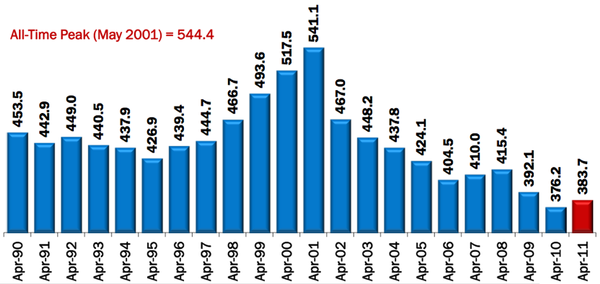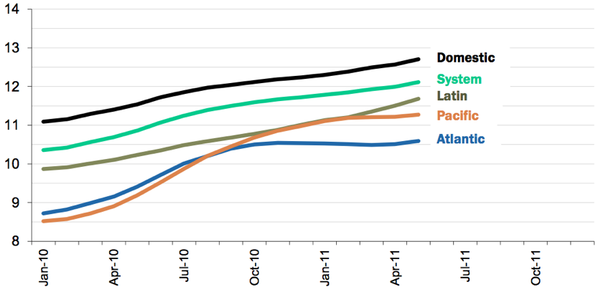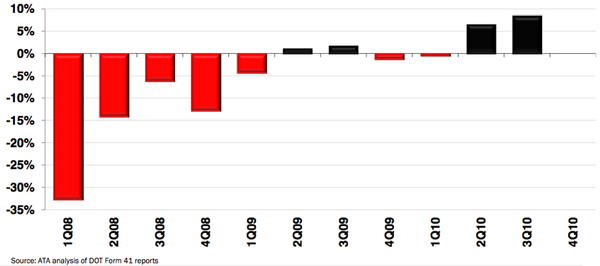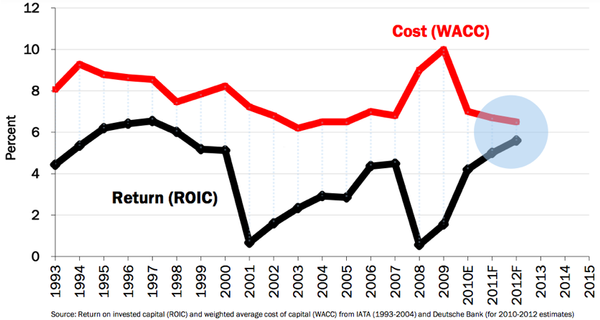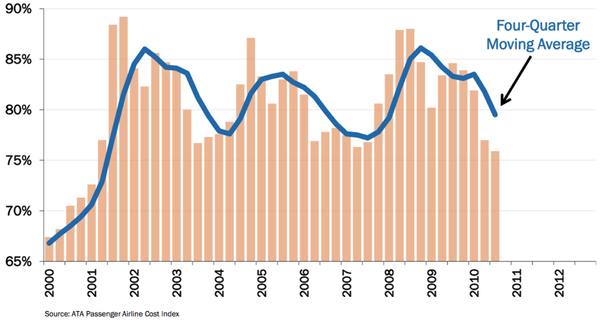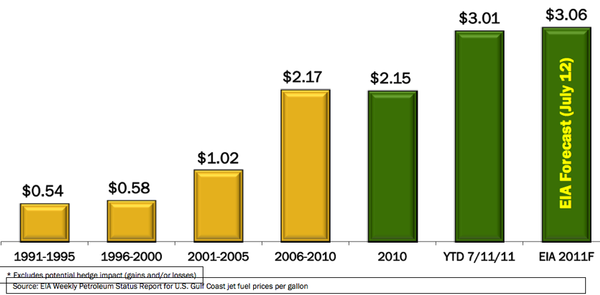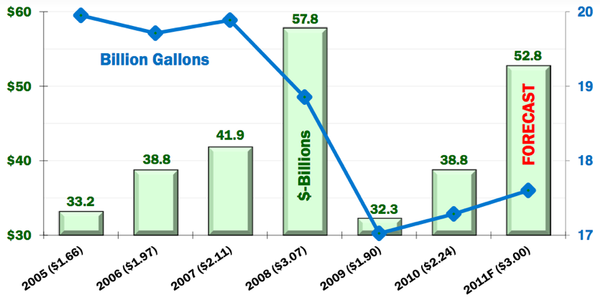Aviation's lost decade? 9/11 and beyond. Cause for optimism in the wake of 9/11 changes
The first decade of the 21st Century has been widely regarded as the US airline industry's lost decade. The reasons behind this are easy to see in the wake of the statistics issued by both the US Air Transport Association (ATA) and the International Air Transport Association (IATA). US airlines were certainly the most profoundly affected of all, but not all of the subsequent malaise can be attributed to 9/11. Nor has all the news been bad. Despite a large industry deficit since 2001 and the loss of many jobs, today's US airline industry is in many ways better placed than it was before 2000.
US Airlines* net income (USD billions) and profit margin (%)
Airline industry's malaise due to more than 9/11
Comparing statistics from 2000 and 2010, however, suggests the industry is financially far better off now than it was a decade earlier. Even so, that conclusion is overly simplistic and belies the wrenching pain, disruptions, the losses, lay-offs and bankruptcies initiated at 08:46 that day.
Systemwide US airline industry (USD millions): 2000 vs 2010
|
Deptrs |
Pax |
RPMs |
ASMs |
LF |
RTMs |
OpRev USD |
NetInc USD |
Margin |
|
|---|---|---|---|---|---|---|---|---|---|
|
2000 |
9035 |
666,149 |
629,757 |
956,950 |
72.4 |
23,888 |
130,248 |
2.533 |
1.9% |
|
2010 |
10,094 |
720,476 |
798,008 |
972,561 |
82.1% |
27,882 |
174,495 |
3.600 |
2.1% |
It also contradicts the fact 9/11 is still costing airlines millions of passengers annually as the hassle factor becomes more acute. But the hassle factor is not the only thing depressing airline potential, as aptly illustrated by the fact Congress allowed FAA authorisation to lapse - which alone cost aviation trust fund coffers more than USD400 million - over a tepid political argument over US13 million in rural airport subsidies.
The airline industry was already undergoing major changes pre-2001
The timing of the attacks came as the US was ending decades of post-war prosperity. The bursting of the tech bubble preceding the attacks, ushered in a decade of decline from which we have yet to recover. Indeed, it is likely to be some time before we see an industry that can be called robust.
9/11 was not an isolated event. Indeed, the industry lost far more in the aftermath of the back-to-back economic and fuel crises. As such, 9/11 was only the first of many catalysts for change that forced an industry collapse no less dramatic than the ashes and dust of those long-dead buildings, airplanes and people.
The industry is still coping with an economic collapse, lengthened by a dysfunctional Washington whose political wrangling helped strangle a nascent recovery. Thankfully, airlines continue to report strong forward bookings even as consumer confidence is at an all-time low. Businesses do not want to repeat the damage done by foregoing travel for a year after the recession began.
By every measure, developing economies are overtaking the engine that was the US. On the one hand, this can be seen as a positive with the appearance of new consumers, yet on the other, can be viewed as a negative. The US was previously 23% of the world's GDP and is currently only 19%. Boeing and Airbus now face growing competition from Asia, Canada, Russia and Brazil. It is likely there will be a shift in the power structure of international alliances and US airlines no longer have the aura internationally that they had many years ago.
Political wrangling has not helped. The debt debate means the industry cannot make the investment needed to give aviation what it needs to prosper - a new air traffic control system and aviation tax reform as well as the recognition of how large a driver these elements are to a healthy economy.
9/11's impact on airlines continues
9/11 cost US airlines USD55 billion in losses and the jobs of 160,000 dedicated and usually skilled workers. With each airline job driving the creation of 12-15 additional jobs, the loss of so many employees has been critical for the entire economy. It took US legacy airlines nearly a decade to recover enough to begin focusing on re-fleeting.
Although US Airways CEO Doug Parker has said these changes would have happened anyway, albeit at a slower pace, this is highly doubtful. Nothing short of these collective disasters, starting with 9/11, would have created a similar scenario.
Despite the painful costs associated with the seismic shift of 9/11 and the numerous aftershocks created by war, pandemics, volcanoes, economic collapse and fuel volatility, the industry is clearly stronger owing to the largest impact of the last decade. Adversity provoked a complete financial restructuring of the industry into something it should have been long ago; one that focuses more on the simple law of supply and demand in order to achieve profitability and less on market share and macho management.
New fiscal management was one outcome
The outcome has been to recreate an industry in which revenues and freight are on the rise, with IATA predicting the industry will reach USD598 billion in revenues this year, nearly twice the USD307 billion posted in 2001. Globally, airlines are expected to carry 2.8 billion passengers, up one billion, and 47 million tonnes of cargo, an increase of 16 million from the cargo traffic since 2001.
One statistic illustrates the beginning of this transformation. It took two years for the industry to stabilise after that September day in 2001. By 2003, the US industry had recovered the USD22 billion revenue decline that occurred between 2000 and 2001, according to IATA. The industry resumed both growth and profitability by 2006/2007, although it was short lived.
Airline executives must be commended for their efforts. However, commendations would not be complete without acknowledging the sacrifices of employees, in both jobs and concessions. They remain testament to the upheaval of the last decade and, along with their respective companies, continue beleaguered.
In 2011, U.S. Airline Employment* beginning to stabilise
The new fiscal management and inter-continental alliances, along with ancillary fees, offer greater hopes of financial stability over the long term as management forges a new, but yet evolving, norm. That is, unless there is another seismic event.
The US and Canadian airline industries are now peopled with solid fiscal leaders who are doing all they can to create balance sheets that will not only withstand fuel increases but simultaneous economic downturns while reporting solid performance. Indeed, as they themselves have described it, they are managing for the bad times.
There is significant reason to be hopeful, at least in regard to what management can do. But as we have seen, a flu epidemic in Mexico can bring travel to a halt and management can do little but look on, cut capacity and wait it out.
Airports were badly affected by the air traffic downturn - and many still are
It took three years after 9/11 for airports to recover and many US airports have yet to recover to the passenger levels enjoyed in 2000.
US enplaned passengers
|
2000 |
2001 |
YoY change |
2002 |
YoY change |
2003 |
YoY change |
2004 |
YoY change |
00/04 Change |
2010 |
00/10 Change |
|
|---|---|---|---|---|---|---|---|---|---|---|---|---|
|
41,040,995 |
34,643,312 |
84.4% |
31,456,342 |
90.8% |
28,786,385 |
91.5% |
32,152,186 |
111.7% |
78.34% |
39,319,324 |
95.8% |
|
|
St. Louis |
30,558,991 |
26,695,019 |
87.4% |
25,626,114 |
96.0% |
20,431,132 |
79.7% |
13,396,028 |
65.6% |
43.84% |
12,331,426 |
40.4% |
|
34,188,701 |
31,100,491 |
91.0% |
29,220,775 |
94.0% |
29,428,899 |
100.7% |
31,893,372 |
108.4% |
93.29% |
33,107,041 |
96.8% |
|
|
80,162,407 |
75,858,500 |
94.6% |
76,876,128 |
101.3% |
79,086,792 |
102.9% |
83,606,583 |
105.7% |
104.30% |
89,331,622 |
111.4% |
|
|
36,865,866 |
35,180,960 |
95.4% |
3,500,9011 |
99.5% |
36,265,962 |
103.6% |
41,441,531 |
114.3% |
112.41% |
39,757,359 |
107.8% |
|
|
25,360,034 |
22,519,874 |
88.8% |
21,986,679 |
97.6% |
22,482,770 |
102.3% |
24,435,619 |
108.7% |
96.35% |
23,983,082 |
94.6% |
|
|
3,034,354 |
2,849,949 |
93.9% |
2,778,342 |
97.5% |
2,700,936 |
97.2% |
2,871,021 |
106.3% |
94.62% |
2,805,692 |
92.5% |
|
|
19,816,511 |
19,945,246 |
100.6% |
18,027,165 |
90.4% |
14,266,984 |
79.1% |
13,271,709 |
93.0% |
66.97% |
8,165,015 |
41.2% |
|
|
33,621,273 |
31,668,450 |
94.2% |
30,060,241 |
94.9% |
29,595,618 |
98.5% |
30,165,197 |
101.9% |
89.72% |
35,698,025 |
106.2% |
|
|
Dulles |
20,104,693 |
18,002,319 |
89.5% |
17,265,163 |
95.9% |
16,950,381 |
98.2% |
22,868,882 |
134.9% |
113.75% |
23,741,603 |
118.1% |
|
27,726,833 |
24,474,930 |
88.3% |
22,646,191 |
92.5% |
22,791,169 |
100.6% |
26,142,516 |
114.7% |
94.29% |
27,428,962 |
98.9% |
|
|
Oklahoma City |
3,481,789 |
3,321,695 |
95.4% |
3,183,408 |
95.8% |
3,260,114 |
102.4% |
3,379,883 |
103.7% |
97.07% |
3,466,127 |
99.6% |
|
O'Hare |
72,144,244 |
67,448,064 |
93.5% |
66,565,952 |
98.7% |
69,508,672 |
104.4% |
75,533,822 |
108.7% |
104.70% |
67,025,191 |
92.9% |
|
23,027,674 |
20,151,935 |
87.5% |
19,749,902 |
98.0% |
18,690,888 |
94.6% |
19,334,674 |
103.4% |
83.96% |
18,443,873 |
80.1% |
|
|
36,771,952 |
33,733,725 |
91.7% |
32,629,690 |
96.7% |
33,201,860 |
101.8% |
36,713,173 |
110.6% |
99.84% |
32,839,441 |
89.3% |
|
|
Portland, OR |
13,790,115 |
12,703,636 |
92.1% |
12,241,975 |
96.4% |
12,390,593 |
101.2% |
13,038,057 |
105.2% |
94.55% |
13,192,857 |
95.7% |
|
15,820,342 |
15,184,332 |
96.0% |
14,931,854 |
98.3% |
15,000,248 |
100.5% |
16,222,726 |
108.1% |
102.54% |
16,889,622 |
106.8% |
|
|
Orlando |
30,823,509 |
28,253,248 |
91.7% |
26,653,672 |
94.3% |
27,319,223 |
102.5% |
31,146,537 |
114.0% |
101.05% |
34,877,899 |
113.2% |
|
24,918,276 |
23,953,052 |
96.1% |
24,799,470 |
103.5% |
24,671,075 |
99.5% |
28,507,420 |
115.5% |
114.40% |
30,775,961 |
123.5% |
|
|
60,687,181 |
55,141,763 |
90.9% |
52,829,750 |
95.8% |
53,252,205 |
100.8% |
59,446,078 |
111.6% |
97.95% |
56,905,600 |
93.8% |
|
|
US total (BTS) |
669,282,000 |
625,065,000 |
93.4% |
616,238,000 |
98.6% |
647,468,000 |
105.1% |
703,691,000 |
108.7% |
105.14% |
720,476,000 |
107.6% |
While traffic suffered globally following the attacks, the impact was far more pronounced in the US than elsewhere; 10 years later the US market has been radically altered.
As the airlines have transformed their management, so too have airports, as airlines put pressure on airport fees. Presently, post-security and airside retail now contribute up to half of airport income, according to Airports Council International (ACI).
Legacy airlines have declined and Southwest, while already a substantial but minor player in 2000, has moved to become the largest US domestic carrier. All of this has had a profound impact on airports, most of which took an immediate hit, as shown in the results in the table above.
In an odd juxtaposition, the only airport in the chart to maintain its 2000 traffic level was Pittsburgh (PIT), the last year in which the airport would show positive numbers. By 2002, Atlanta (ATL) and Philadelphia (PHL) had both stemmed the decline and in subsequent years all but Pittsburgh and St Louis (STL), both suffering from a loss of their anchor carrier, had stabilised.
But for most, it was stabilisation at a lower passenger count. Looking at the 2000/2004 comparison column, only seven of the 20 selected airports had achieved or exceeded their 2000 passenger figures by 2004. While Philadelphia showed the best performance of those selected, its traffic rose as US Airways pulled back from Pittsburgh and Southwest arrived at Philadelphia.
Las Vegas was for some time in the midst of a real estate boom that turned sour in 2008 but still left traffic levels higher in 2010. San Francisco was among the hardest hit post 9/11 - eventually losing approximately 40% of its seat offer before the turnaround came.
Yet, by 2010, only seven of the 20 airports had surpassed their 2000 passenger numbers, with St Louis and Pittsburgh having less than half of their passenger counts registered a decade earlier. Looking at the total enplaned passenger numbers from the Bureau of Transport Statistics, total passenger growth over the entire decade was only 7.6%. This contrasts with a greater than 13% overall growth between 1996 and 2000. Still, at least it was growth.
After a briefly rosy economic climate, airlines were hit by fuel spikes and economic crisis
It was not until the fuel/economic crisis of 2008 that airlines dropped capacity back to 2000 levels and further shrank the US fleet by about 700 units. The global financial crisis caused more than double the revenue losses resulting from the 2001 attacks, at 14% (USD82 million). Total US domestic capacity in 2010 remains 4% below the 2000 level, according to IATA.
After restructuring through bankruptcy, most of the US industry was on its way to a new normal when the fuel and economic crises hit and management realised they could no longer afford the vast networks and fleets they had created. Instead, they accelerated the development of not only international alliances but also joint ventures to deliver the worldwide connectivity they had once tried to deliver on their own.
The fallout has been the wholesale shift of much of the domestic market to low-cost carriers and regionals, while legacies chase the money spent by business travellers, especially in the international arena. Indeed, without 9/11 and the subsequent bankruptcies, the fortunes of low-cost carriers and regionals would have been far different. But that ignores the role they played in the process - a chicken-and-egg interaction.
Recovery of US domestic and Latin airline markets continues: trans-Atlantic/Pacific revenue is lagging, but on the mend
US airlines' 12-month rolling passenger revenue* per available seat mile (PRASM)
For an in-depth view of the way the rest of the world's airlines have changed and where US carriers fit in, see: A decade of change for the global airline industry: A new and altered reality in the rankings
A decade of transition - to better industry fundamentals
In light of the bumpy road since 2001, it is surprising the airline industry is doing so well, with most metrics up from 2000. Not only are the airlines carrying more passengers but they are doing so at higher revenues and profits - although the sum of the profits during the decade remain far short of the cumulative losses.
EBITDAR* profit margins: US passenger airlines
US domestic airline metrics (millions): 2000 vs 2010
|
Pax |
RPMs |
ASMs |
LF |
|
|---|---|---|---|---|
|
2000 |
610,501 |
508,403 |
714,454 |
71.2% |
|
2010 |
641,685 |
562,242 |
685,245 |
82.1% |
US international airline metrics (millions): 2000 vs 2010
|
Pax |
RPMs |
ASMs |
LF |
|
|---|---|---|---|---|
|
2000 |
55,549 |
184,345 |
242,496 |
75% |
|
2010 |
78,791 |
235,766 |
287,316 |
82.1% |
The triple crises resulted in an entirely new management philosophy based on return on invested capital (ROIC) and the realisation the industry was seriously over built with too many aircraft flying between too many hubs with not enough profits.
Clearly, the industry has a long way to go before recovering capital costs, which hover around 6.5% while ROIC remains below 6%. But the actions of today's airline executives have forged a clear path to change that to 10% over the course of the business cycle.
US airline ROIC below WACC translates to loss of investor wealth
Break-even Load Factors are below 80% again
An indication of improved yields, realistically achievable load factors can now put airlines in the black.
Yields (fares per mile) closing gap to unit costs of operation: 2000 to 2011
The cost reductions squeezed out of the industry were accomplished despite headwinds that included an unprecedented rise in fuel from USD1.02 per gallon in 2001 to an expected USD3.06 this year.
The external threat: airline energy costs are high and poised to rise
Despite the flagging economy, fuel prices remain relentlessly high, a cause for continuing concern, about which airlines can do little.
A USD3.00 increase in Jet Fuel prices would raise US Airlines' 2011 Fuel Bill by USD15bn*
US airline industry fuel costs will likely be more than USD52.8 billion this year - only USD5 billion shy of 2007 levels - despite the fact that fuel consumption remains below 2005 levels.
Airlines remain fragile operations, despite improved financial performance
Despite the efforts of the industry to cut costs and raise revenues, it continues to face huge challenges beyond fuel. Domestic travel has not recovered and there is no estimate of when that might happen. Certainly the impact of Washington infighting is depressing both consumer and business spending. Those who pegged 2014 for full recovery may not be far wrong - at least it is unlikely to be before then.
Spending on Domestic Air Transport Has Not Recovered Total Domestic Operating Revenue (¢) per USD100 of US GDP*
Further consolidation and a total re-write of labour-management relations will be necessary to entrench a solidly sustainable future for the industry. These alone are big asks.

